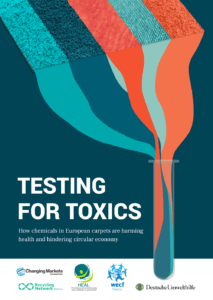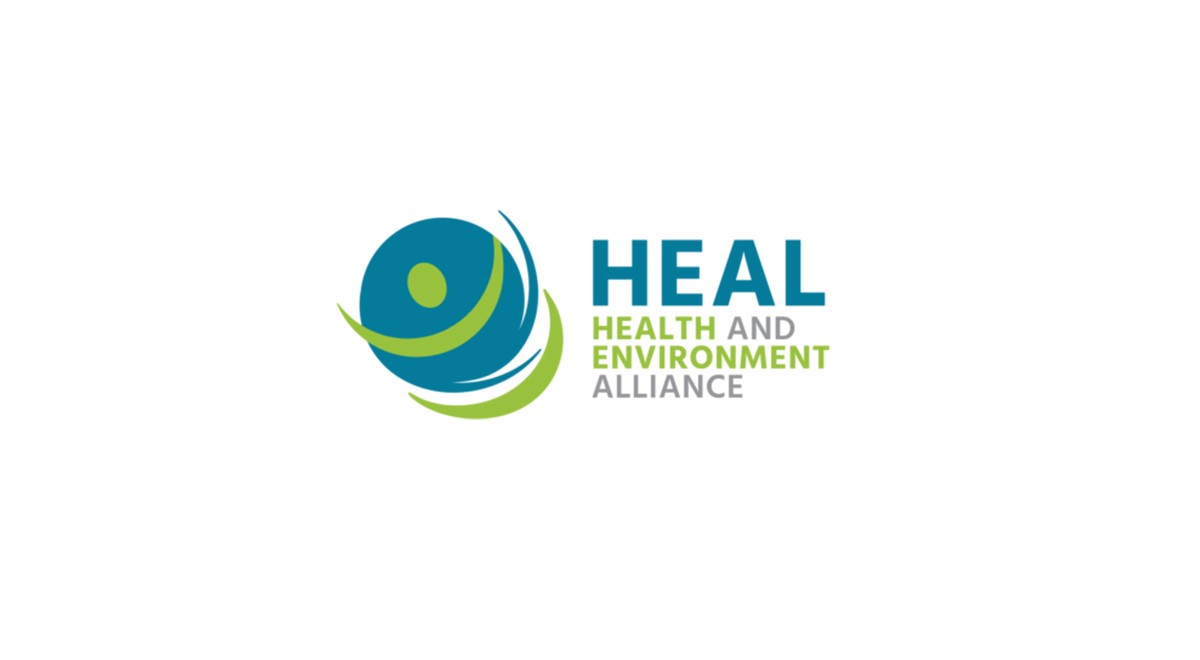Are you our new Communications Officer?
New research has found toxic chemicals in carpets produced and sold by some of the largest carpet manufacturers on the European market. These chemicals include suspected carcinogens, endocrine disruptors and reprotoxics that could both pose a health risk and prevent the industry moving towards a non-toxic circular economy.
 Based on research by the Vrije Universiteit Amsterdam (Netherlands), the Ecology Center (US) and the University of Notre Dame (US), the report, Testing for Toxics: How chemicals in European carpets are harming health and hindering circular economy, presents the results of testing of carpet samples from the seven largest manufacturers in the EU, including Milliken, Forbo, Interface, Tarkett and Associated Weavers.
Based on research by the Vrije Universiteit Amsterdam (Netherlands), the Ecology Center (US) and the University of Notre Dame (US), the report, Testing for Toxics: How chemicals in European carpets are harming health and hindering circular economy, presents the results of testing of carpet samples from the seven largest manufacturers in the EU, including Milliken, Forbo, Interface, Tarkett and Associated Weavers.
The investigation found phthalates in three carpets – two in carpets produced by Forbo and one in a carpet produced by Associated Weavers. Among them was the phthalate DEHP, which is an endocrine disruptor that has been banned in the EU since 2015, but is still allowed in recycled PVC, showcasing inconsistent regulations for virgin and recycled materials [1].
Two carpets produced by Milliken were found to contain TDCPP, a chlorinated flame retardant that is classified by the European Chemicals Agency (ECHA) as a suspected carcinogen [2]. One Milliken carpet also contained a number of fluorinated stain repellants (PFASs), including one which is a suspected carcinogen and one which is suspected to be a reprotoxic substance and an endocrine disruptor [3].
The report builds upon previous research which highlighted the possible presence of over 50 toxic substances in European carpets [4] and exposed potential loopholes in EU regulations and in voluntary certification schemes. The new findings reveal the real-life impacts these policy gaps could have on vulnerable groups, such as babies and small children. For example, certain hazardous substances, such as halogenated flame retardants, are strictly regulated under the Toys Safety Directive, but they are permitted in and were detected in carpets samples tested for this report.
“These results are yet another confirmation that EU law is leaving loopholes for toxic materials to be recycled into our everyday products. Chemicals that can harm our health – and especially the health of vulnerable groups such as babies – should not be part of carpets design in the first place. If the EU is serious about a non-toxic circular economy, it should not allow for carcinogens or endocrine disruptors to stay in the production cycle, and it should push the carpet industry to urgently remove toxics from the manufacturing loop altogether,” said Génon Jensen, Executive Director of Health and Environment Alliance (HEAL).
Sascha Marschang, Acting Director, European Public Health Alliance (EPHA) commented on the findings: “The need to move towards a circular economy is apparent, but we cannot allow chemicals that pose human health risks to circulate alongside. This report suggests we need to establish a watertight regulatory framework that meets both health and environmental goals. Apart from the need to expand controls on chemicals, the report highlights once more the importance of conducting detailed health impact assessment when preparing policy files, in order to guard against unforeseen consequences and ensure the credibility of policy initiatives.”
On the positive side, the report highlights three carpets in which no toxic chemicals were detected (including one from Interface and one from Tarkett), indicating that it is possible to produce toxic-free carpets, even from recycled materials.
The report calls on manufacturers to ensure that their products are designed for a healthy and circular economy. It also calls upon the EU and national governments to expand bans on hazardous chemicals, close loopholes in chemicals regulation and end exemptions for chemicals in recycled materials. The EU Commission’s upcoming proposals to tackle the interface between chemicals, product and waste legislation is an opportunity to address some of these issues and ensure that recycled materials comply with the same chemicals regulations.
Finally, the report recommends putting in place measures to realise a circular economy in the carpet sector, which can be done through mandatory Extended Producer Responsibility (EPR) schemes with minimum requirements, including bans on toxic chemicals.
“The carpet sector has a unique opportunity to lead the transformation towards circular economy, as several companies have shown that they can produce toxic-free recyclable carpets. Governments have a key role to play in this transition, as they can put in place ambitious policies encouraging producers to ramp up their recycling efforts. This will hopefully convince the laggards in the industry to stop selling sub-optimal products and instead invest in better design, collection and recyling,” concluded Nusa Urbancic, Campaigns Director from The Changing Markets Foundation.
Substances chimiques toxiques dans les moquettes : un danger pour la santé et un frein pour une économie circulaire non toxique
 Dans la continuité d’un rapport de mars 2018 [1], de nouvelles recherches révèlent la présence de substances chimiques toxiques dans des moquettes vendues sur le marché européen. Des substances potentiellement cancérogènes, toxiques pour la reproduction et perturbateurs endocriniens ont notamment été retrouvées. Outre les dangers qu’elles peuvent représenter pour la santé, elles sont un frein au développement d’une économie circulaire non toxique dans le secteur. Alors que la Commission européenne travaille actuellement sur l’interface entre les législations sur les substances chimiques, les produits de consommation et les déchets, les auteurs rappellent que la mise en place d’une économie circulaire ne doit pas se faire au détriment de la santé.
Dans la continuité d’un rapport de mars 2018 [1], de nouvelles recherches révèlent la présence de substances chimiques toxiques dans des moquettes vendues sur le marché européen. Des substances potentiellement cancérogènes, toxiques pour la reproduction et perturbateurs endocriniens ont notamment été retrouvées. Outre les dangers qu’elles peuvent représenter pour la santé, elles sont un frein au développement d’une économie circulaire non toxique dans le secteur. Alors que la Commission européenne travaille actuellement sur l’interface entre les législations sur les substances chimiques, les produits de consommation et les déchets, les auteurs rappellent que la mise en place d’une économie circulaire ne doit pas se faire au détriment de la santé.
Des produits chimiques préoccupants détectés dans différentes moquettes
Intitulé « A la recherche des toxiques : en Europe, les produits chimiques présents dans les moquettes sont un danger pour la santé et un frein pour l’économie circulaire », le nouveau rapport réalisé par la fondation Changing Markets est basé sur les recherches de la Vrije Universiteit d’Amsterdam et de l’Ecology Center et l’Université de Notre Dame (États-Unis). Les moquettes testées, issues de 7 des plus grands fabricants de l’UE (dont Milliken, Forbo, Interface, Tarkett et Associated Weavers) révèlent la présence de :
- Phtalates, dont le DEHP, perturbateur endocrinien interdit dans l’UE, mais autorisé par dérogation dans le PVC recyclé, dans 3 échantillons Forbo et Associated Weavers
- TDCPP, retardateur de flamme chloré, cancérigène présumé, dans 2 échantillons Milliken
- Produits antitaches fluorés (PFAS), dont un cancérogène présumé, une substance suspectée d’être reprotoxique et un perturbateur endocrinien
- Retardateurs de flamme halogénés, autorisés dans les moquettes, mais réglementés par la Directive sécurité des jouets pour leur dangerosité.
Des dérogations pour les produits recyclés contraires à la protection de la santé
« Si l’Union européenne tient vraiment à une économie circulaire non toxique, elle ne doit pas permettre aux substances cancérigènes ou perturbateurs endocriniens de rester dans le cycle de production. Au contraire, elle doit inciter les fabricants de moquettes – et d’autres secteurs – à évoluer vers des produits plus sains. » déclare Genon Jensen, directrice exécutive de l’Alliance santé et environnement (HEAL). Un point positif cependant : 3 moquettes Interface et Tarkett, issues de matériaux recyclés ne contiennent aucun des produits chimiques recherchés. « Il faut encourager une harmonisation vers le haut des réglementations, pour mieux protéger la santé : pourquoi de telles différences entre les réglementations des produits neufs ou recyclés ? Ou entre une moquette ou un jouet, puisque les jeunes enfants sont au contact direct des deux ? » déclare Elisabeth Ruffinengo, responsable plaidoyer pour WECF France.
Des recommandations à l’attention des pouvoirs publics et des fabricants
Les auteurs demandent aux fabricants d’intensifier les efforts de conception, de collecte et de recyclage pour des produits conformes à une économie saine et circulaire. Ils demandent à l’UE et aux gouvernements des Etats membres de combler les lacunes réglementaires, étendre les interdictions des substances chimiques dangereuses, et mettre fin aux exemptions applicables aux produits chimiques présents dans des matériaux recyclés. Les auteurs proposent également de rendre obligatoires les régimes de responsabilité élargie des producteurs (REP) avec des exigencesminimales, d’interdiction de substances chimiques toxiques. Télécharger le rapport complet (en anglais) : https://changingmarkets.org/portfolio/carpet-recycling/
Télécharger en français : https://www.env-health.org/wp-content/uploads/2018/10/changing-markets-digital-FR.pdf
Notes :
[1] Un précédent rapport Toxics in carpets in the European Union de Anthesis Consulting Group (mars 2018) avait mis en évidence la présence possible de plus de 50 substances toxiques dans les moquettes européennes, et dévoilé des failles potentielles dans les réglementations européennes et les systèmes de certification volontaire. Consulter la synthèse (en français).


